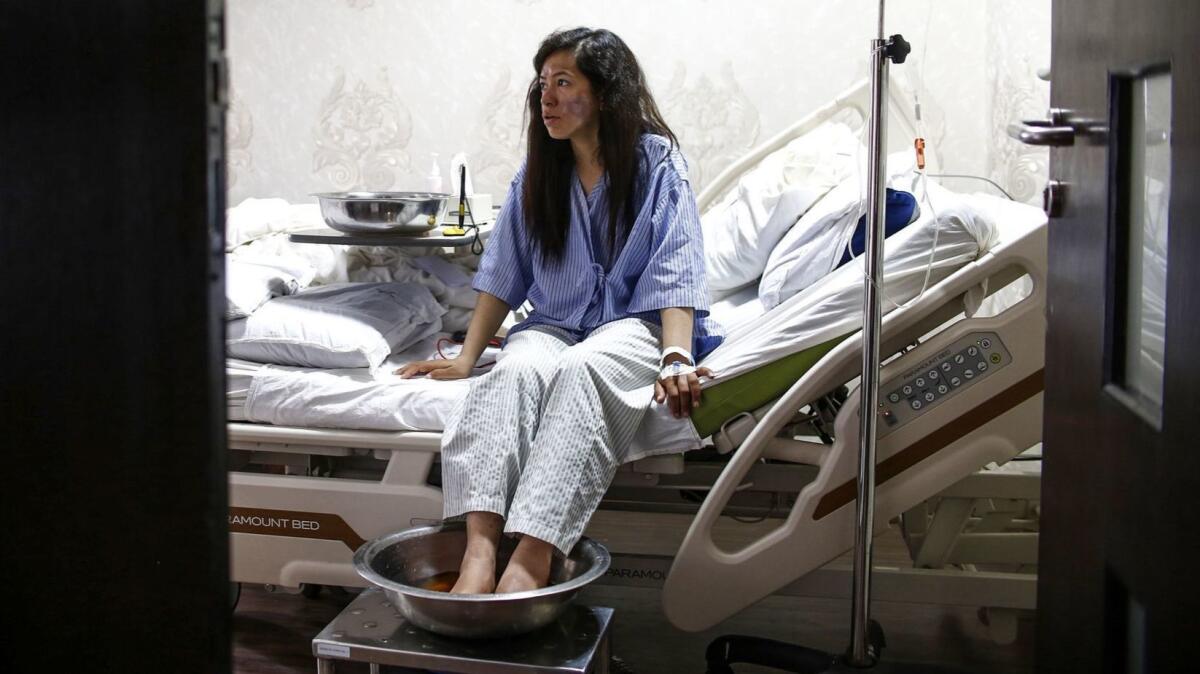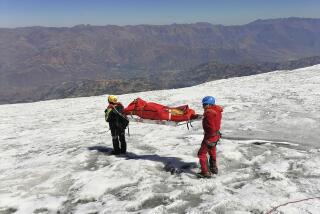Mt. Everest death toll rises to 11 as Nepal defends issuing hundreds of permits
Reporting from NAMCHE, Nepal — Scaling Mt. Everest was a dream few realized before Nepal opened its side of the mountain to commercial climbing half a century ago. This year the government issued a record number of permits, leading to traffic jams on the world’s highest peak that probably contributed to the greatest death toll in four years.
As the allure of Everest grows, so have the crowds, with inexperienced climbers faltering on the narrow passageway to the peak and causing deadly delays, veteran climbers said.
Nepal’s tourism officials have no intention of restricting the number of permits issued despite the deaths of 11 people this year, instead encouraging even more tourists and climbers to come “for both pleasure and fame,” said Mohan Krishna Sapkota, secretary at the Ministry of Culture, Tourism and Civil Aviation.
Nepal, one of the world’s poorest countries, relies on the climbing industry to bring in $300 million each year. It doesn’t cap the number of permits it issues or control the pace or timing of the expeditions, leaving that to tour operators and guides who take advantage of brief clear weather conditions whenever they come, leading to pileups near the peak.
On May 22, a climber snapped a photo from a line with dozens of hikers in colorful winter gear that snaked into the sky.
Climbers were crammed crampon-to-crampon along a sharp-edged ridge above South Col, with a 7,000-foot drop on either side, all clipped onto a single line of rope, trudging toward the top of the world and risking death as each minute ticked by.
“There were more people on Everest than there should be,” said Kul Bahadur Gurung, general secretary of the Nepal Mountaineering Assn., an umbrella group of all expedition operators in Nepal.
The death toll this season is the highest since 2015. Most of those who died are believed to have suffered from altitude sickness, which is caused by low amounts of oxygen at high elevation and can cause headaches, vomiting, shortness of breath and mental confusion.
Once accessible only to well-heeled elite mountaineers, Nepal’s booming climbing market has driven down the cost of an expedition, opening up Everest to hobbyists and adventure seekers. They are required to have a doctor’s note deeming them physically fit, but not proof of stamina at such extreme heights.
Because of the altitude, climbers have just hours to reach the top before they are at risk of high altitude pulmonary edema, when the lungs fill with liquid. From Camp Four at 26,240 feet to the 29,035-foot peak, the final push on Everest is known as the “death zone.”
The conditions are so intense that when a climber dies, the body is left on the mountain; no one can afford to expend energy on carrying the body down.
“Every minute counts there,” said Eric Murphy, a mountain guide from Bellingham, Wash., who on May 23 climbed Everest for a third time. He said what should have taken 12 hours took 17 hours because of struggling climbers who were clearly exhausted but had no one to guide or help them.
Just a handful of inexperienced climbers, he said, is “enough to have a profound effect.”
The deaths this year on Nepal’s side of the mountain included Don Cash, a sales executive from Utah, and Christopher Kulish, an attorney from Colorado, who both died on their way down from the peak.
Kulish, 62, had just reached the top with a small group after crowds of climbers congested the peak last week, according to his brother, Mark Kulish.
He described his brother as an attorney who was an “inveterate climber of peaks in Colorado, the West and the world over.” Just before he died, Kulish made it into the so-called Seven Summits Club of mountaineers who have reached the highest peaks on every continent, his brother said.
Cash, 55, collapsed at the summit and was given CPR and massages by his two Sherpa guides, according to Pasang Tenje Sherpa, head of Pioneer Adventure, which provided the guides. Cash got up only to fall again in the same way at Hillary Step, the first cliff face down from the summit; his body was left near there.
Cash had said on his LinkedIn page that he left his job as a sales executive to try to join the Seven Summits Club.
Nepal doesn’t have any regulations on the books to determine how many permits should be issued, so anyone with a doctor’s note can obtain one for an $11,000 fee, Sapkota said.
This year, permits were issued to 381 people, the highest number ever, according to the government. They were accompanied by an equal number of guides from Nepal’s ethnic Sherpa community. Some of the climbers were originally issued permits in 2014 that were revoked midseason when 16 Sherpa guides died in an avalanche and other Sherpas, whose support as guides and porters is essential, in effect went on strike.
Another factor in crowding was the reduced number of permits issued by China for routes on the north side of Everest to allow for a cleanup. The northern and southern sides of the mountain are littered with empty oxygen canisters, food packaging and other debris. Chinese state media have said the cleanup will include retrieval of bodies of climbers left above Camp Four.
Instead of the overcrowding, Sapkota blamed the weather, equipment and inadequate supplemental oxygen for this year’s deaths.

“There has been concern about the number of climbers on Mt. Everest, but it is not because of the traffic jam that there were casualties,” Sapkota said in Namche, the town that serves as the staging area for Everest trips.
Still, he said, “in the next season we will work to have double rope in the area below the summit so there is better management of the flow of climbers.”
Instead of limiting the number of people who attempt to reach Everest’s peak, Sapkota said, Nepal’s government will encourage even more tourists and climbers to come “for both pleasure and fame.”
Mirza Ali, a Pakistani mountaineer and tour company owner who reached Everest’s peak for the first time this month, on his fourth attempt, said such an approach was flawed.
“Everybody wants to stand on top of the world,” but tourists unprepared for the extremes of Everest endanger the entire industry, he said.
“There is not a sufficient check on issuing the permits,” Ali said. “The more people come, the more permits, more business. But on the other side, it is a lot of risk because it is costing lives.”
Indian climber Ameesha Chauhan, recovering from frostbitten toes at a hospital in Katmandu, described the agony of turning away from the peak when she realized her supplemental oxygen supply was low.
Two of her team members died on the May 16 ascent.
She returned and scaled the peak a week later.
“Many climbers are too focused on reaching the summit,” she said. “They are not only risking themselves but also putting others at risk.”
More to Read
Sign up for Essential California
The most important California stories and recommendations in your inbox every morning.
You may occasionally receive promotional content from the Los Angeles Times.










